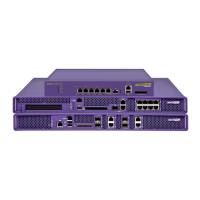
Do you have a question about the Extreme Networks Summit WM3000 Series and is the answer not in the manual?
| Category | Controller |
|---|---|
| Interface Types | Gigabit Ethernet |
| Power over Ethernet (PoE) | No |
| Redundancy | Yes |
| VLAN Support | Yes |
| QoS Support | Yes |
| Wireless Standards | 802.11a/b/g/n |
| Wireless Security | WPA, WPA2, 802.1X |
| Ports | 4 x 10/100/1000 Ethernet |
| Power Supply | Internal |
| Management | Web-based, CLI, SNMP |
| Operating Temperature | 0°C to 40°C (32°F to 104°F) |
| Storage Temperature | -20°C to 70°C (-4°F to 158°F) |
| Model | Summit WM3000 Series |
Details the features related to managing wireless traffic and connectivity.
Covers the features for managing wired network connections and ports.
Outlines the wireless and wired security mechanisms available on the controller.
Guides the initial connection and access to the controller via a web-enabled laptop.
Guides the initial setup of essential controller parameters like country code and location.
Explains the process for updating the controller's firmware to the latest version.
Explains the process for updating the controller's firmware via Web UI, FTP, or TFTP.
Explains how to view and configure VLANs by port and ports by VLAN information.
Details the setup and configuration of virtual interfaces (CVIs) for Layer 3 access and routing.
Covers the configuration and monitoring of wireless LANs, including assignments and security schemes.
Explains how to configure hotspot functionality for user authentication via a web page.
Details the configuration of WLAN encryption options like WEP, WPA, and WPA2.
Covers viewing and configuring radio settings for Access Points.
Modifies existing radio properties like placement, channel, and power settings for APs.
Manages how WLANs are assigned to AP radios and BSSIDs.
Modifies default radio settings for AP adoption.
Manages firmware images for adopted Access Points.
Details activities related to configuring DHCP server settings.
Covers the configuration of Secure Network Time Protocol for time synchronization.
Explains how to set up redundancy groups and clusters for high availability.
Details the mechanism for maintaining Layer 3 addresses during roaming across subnets.
Describes the process of discovering devices on the network using SNMP.
Configures settings to detect potentially hostile Access Points.
Details the setup and configuration of firewalls and access control lists.
Explains Network Address Translation for IP address translation.
Covers the configuration of IKE parameters for IPSec security.
Details the process of defining secure tunnels for virtual private networks.
Explains how to set up and manage the Radius server for authentication.
Covers the creation and management of server certificates.
Controls management access to the controller via various protocols.